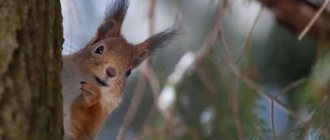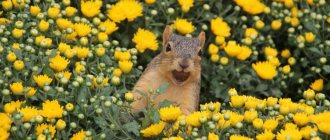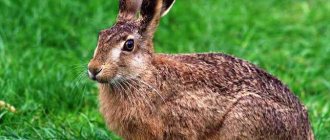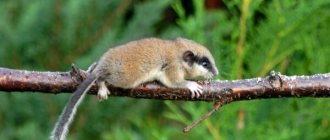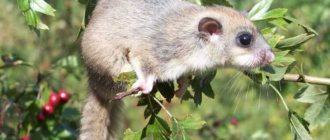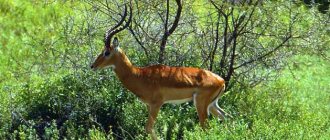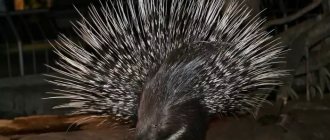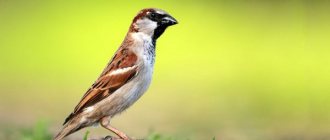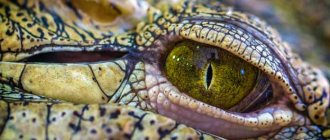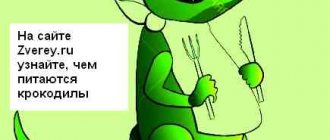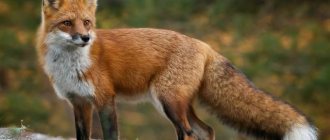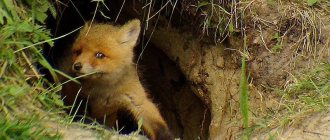Hare (lat. Lepus) – refers to mammals. You cannot call it a harmless animal; in a critical situation it can become aggressive and fight back the enemy.
Since ancient times, hares have been good prey for hunters; meat and fur were especially valuable.
Appearance of a hare
Hares are small animals. The body is oblong, on average 68-70 cm long, the head is neat, and there is a small rounded tail. The hare weighs 2-7 kg.
The body of hares is covered with fur. The color changes depending on the time of year. In summer, the coat has an uneven, mottled color. The color palette includes various shades of brown, gray, and red.
The downy undercoat is darker in color. In the belly area the fur is white. With the onset of winter, the hare changes its coat to a lighter one, and the mountain hare to completely white.
Thus, furry animals molt in spring and autumn. Only the tips of the ears of all types of hares remain black all year round.
A characteristic feature of the hare's appearance are its long ears (from 9 to 20 cm depending on the species), thanks to which the hare is famous for its excellent hearing.
Hares have a special structure of the musculoskeletal system: the hind legs are much longer than the front ones, they are narrow, strong, and have an elongated foot.
This structure of the hind legs helps the animal escape from predators, running away from them at speeds of up to 80 km/h, making huge jumps up to 3-4 meters in length.
From the photo you can evaluate the hare’s excellent physical characteristics.
It is worth noting the fact that the right and left limbs are asymmetrical. Therefore, the hare does not run straight, but rather loops around.
Note!
- Animals of the Red Book of Russia: complete list of animals, photo, name, description
- A Guide to Fish Oil and Omega-3
- Koala: photo, lifestyle, habitat, habits, character, types, interesting facts
Also, while running, he is able to sharply change the direction of his movement, easily climb up a hill, and get the hang of descending, rolling head over heels.
Due to the fact that lagomorphs feed on plant roughage, their teeth have a special structure. There are no fangs, but there are 2 pairs of incisors in the upper jaw on the right and left. The incisors are constantly growing as they are quickly worn down.
Lifestyle and habits
This long-eared animal leads a twilight-nocturnal lifestyle. During the day, the animal rests on ditches. True, in places where there is a high number of obliques, the habits of the hare change and, often, it is active during the day.
Unlike rabbits, the scythe does not dig deep holes. A hare hole is a small depression in the ground, under bushes or tree roots. These animals choose their beds depending on the terrain and weather conditions. In warm, clear weather, they can roost almost anywhere if there is at least a small shelter nearby. In winter, finding places to lie down is not a problem at all, since hares sleep right in the snow.
The oblique runs very fast, while running it often makes long jumps and can suddenly change direction. This method of movement helps the animal escape from the predators pursuing it. Eared cunning creatures are excellent at confusing their tracks. At the slightest threat, the animal freezes motionless until it considers that nothing threatens it anymore.
Many people wonder if hares can swim. Although they do not like water and try to stay away from it, they swim well.
This is a practically voiceless animal; even during the mating season they behave silently, only occasionally voicing. And only the wounded hare emits a loud cry, reminiscent of the cry of a baby.
Hare food
Hares are herbivores. In spring and summer, they do not experience difficulties with nutrition.
The main component of the diet is grass, supplemented by green parts of various plants (stems, leaves, shoots), roots, berries, and mushrooms.
Hares are not afraid to visit farmland and enjoy eating vegetables and grains.
In winter, it becomes difficult for the hare to find food for itself; it has to feed on the bark and branches of plants, dry grass from under the snow, and pine cones.
It has been established that hares eat not only plant foods. In particularly hungry times, hares can feed on the meat of dead birds and even their own droppings.
What do lagomorphs eat?
All hares and rabbits are strictly herbivores. The diet includes green parts of plants, grasses, clover, cruciferous and complex plants. In winter, the diet includes dry twigs, buds, young tree bark, roots and seeds. In steppe regions, the winter diet consists of dry weeds and seeds. Most of all, hares like cultivated plants such as winter grains, rapeseed, cabbage, parsley and cloves. Hares and rabbits damage cereals, cabbage crops, fruit trees and plantations, especially in winter. Hares rarely drink; they take moisture from plants, but sometimes they eat snow in winter.
Peculiarities of behavior of hares
Hares are active in the evening and at night.
Hares are completely non-cowardly and harmless. Possessing well-developed muscles in their hind legs, they can injure those who try to catch them.
Hares are smart. They have a unique way of hiding from an attacker: first they confuse their tracks, and then they hide and can remain motionless for a long time.
Hares communicate by rapidly striking the ground with their front paws (“drum roll”).
In ordinary life, hares do not vocalize, but they scream loudly at the moment of mortal danger.
About hares
When it comes to hares, one always gets the idea that they are a very good-natured and fearful creature, but this is far from the case.
When communicating with a dog, a hare is able to adopt its habits; it can attack and even try to bite.
And there is no reason to call a hare “slanty”; this is a mistaken opinion of hunters; its eyes are no different from other animals.
The running style in the form of looping is associated with a slightly asymmetrical development of the paws.
White hare
This species lives mainly in the northern regions, taiga and tundra, where snow cover is formed for most of the year (territory of Russia, northern part of Europe).
It got its name for its absolutely white fur in the winter season, which is a means of camouflage from enemies.
In the warm season, the hare molts, acquiring a gray coat. White hare can be found in other countries (Mongolia, China) and even continents (South America).
Red Book
Photo: Brown hare
This species of hares is in the “least concern” category. Under favorable conditions, the number of brown hares reaches up to several million per year, so there is no point in worrying about them. The only thing that is debilitating the species is epizootics and lack of food.
Brown hare
The species is distinguished by the large size of its representatives. The coat color does not change throughout the year, it is motley, brownish-reddish.
The hare is an inhabitant of the steppe regions (southern regions of Europe, Kazakhstan, Turkey, northern Africa).
Where do hares live?
The most common habitats: steppes and forest-steppes, desert-steppe areas, forests, fields, meadows. They prefer to be closer to rural areas.
They adapt quite quickly to harsh weather conditions; they can even live in Australia and New Zealand, with the only exception being Antarctica.
- Detailed description with photos of all animals included in the Red Book of Russia
Zebra - habitats, appearance, diet and behavior, life cycle + 94 photos
- Leopard - habitats, life cycle, rutting season and lifespan + 118 photos
The peak of activity comes in the dark (evening, night). They can spend the night in abandoned burrows of foxes and badgers.
Chinese hare
The smallest representative of lagomorphs. The weight of an adult hare is no more than 2 kg. The fur is short, hard, brown. The habitat is limited to the highlands and hilly regions of China and Vietnam.
Interesting Facts
There have always been many legends around the hare. One of them is a horned hare - does such an animal exist? This mythical animal appears in many cultures, acquiring either sharp predatory fangs or wings in addition to its horns. There is even a city in the USA that is declared the capital of horned hares. Souvenir licenses for shooting hares are sold there.
Why is the hare called oblique?
In Russian literature this name can often be heard and there is some truth in this. All this is due to its interesting structure of the eyes - they are located on the sides of the head. When a hare runs away from something, it looks sideways and can crash into a tree, and if it looks forward, its eyes converge at its nose, which is very similar to strabismus.
Is the hare a rodent or not?
Many people believe that the hare is a rodent because it constantly gnaws on something, but this is not so. They are distinguished from rodents by the structure of the palate and the presence of two incisors.
Yellowish hare
The species is found in only one place on the planet: the coastal grasslands of the Gulf of Tehuantepec in Mexico.
The yellowish hare can be distinguished from other species by the black and white stripes that run from the base of the ears to the back of the head.
Interaction between animals
There are several types of hares, but regardless of this, they all use the same danger warning system. When a threat approaches, they begin to squeak and intensively stomp their paws on the ground. This allows you to warn other hares about the danger in order to successfully avoid it.
Manchurian hare
Representatives of the species are small in size with short legs and ears. The coat color is gray-brown with a dark stripe on the back.
They live in deciduous forests of the Russian Far East, northern regions of China and Korea.
Lifestyle
Brown hare is alarmed
According to data obtained by the Max Planck Institute for Demographic Research, the average life expectancy of brown hares is 12 years. In captivity they live 6-7 years.
The lifestyle is lonely. Under favorable conditions for the species, the brown hare becomes a territorially sedentary animal. Able to feed for a long time in one area of 30-50 hectares.
It can run into neighboring territories in search of food, and then return to its bedding (the animal’s shelter). In summer, the bed is a small dug hole in the bushes or under fallen trees.
Activity is observed at night. Mainly in the first half of the night and in the hours before dawn. During the rutting season, brown hares can be seen during the day.
Under poor feeding conditions, natural migration occurs.
In order to avoid being caught by predators, the species has developed the ability to hide its mark. On their own, silent animals.
Photos of hares
Natural enemies
Regardless of their living conditions, hares have a lot of natural enemies. The main enemies are foxes and wolves, and hares living in colder climatic zones also have stoats, lynxes, etc., including birds of prey such as eagle, hawk, eagle owl. Hares living in warmer climates are attacked by hyenas, jackals, etc. For hares that inhabit the area around populated areas, dogs, including homeless ones, as well as pets, pose a danger.
Well, and, of course, the main enemy is man, in the form of hunters who hunt hares, since they have quite tasty meat and valuable fur.
